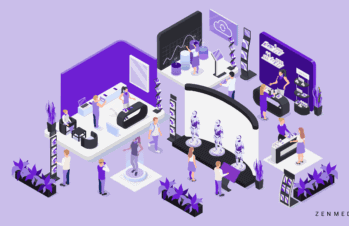If you attended an event in the past few years, you’ve felt something has changed. Events went from canceled indefinitely to remote to hybrid to in-person with hybrid and remote options. The rollercoaster of expectations and regulations has been a lot, especially for businesses that depend on events to drive leads.
In Q4 of 2020, the B2B exhibit cancellation rate was 97.9%. Within a year, in Q4 of 2021, the cancellation rate was down to 12.5%. So while everyone adapted to a virtual world, this significant drop illustrates that people are ready for live events again and adapting to “the new normal.”
People are investing in travel to live events despite rising gas prices and airline tickets. There is a pent-up demand for connection, but the standards and expectations are different than they were before. The last two years have changed how attendees view events, and the ROI standards for event marketing are higher than ever before.
Here at Zen Media, we do a lot of B2B event marketing for our clients. Whether they are attending a trade show and need to know how to leverage that experience fully, or they are hosting their own event for the first time, we’ve guided them through the process. In fact, our president Stephanie Chavez is one of the world’s top 1% of event marketers!
But the bar is higher now. People are more protective of their time; they want connection and new experiences—not just the illusion of it. They want flexibility and fun.
So how can businesses decide what kind of event to plan? And how can they meet (and exceed) the new consumer expectations? Check out the criteria below and see if you’d benefit most from a hybrid, virtual or in-person event!
You need a hybrid event if…
You want to increase your reach and flexibility.
Hosting a hybrid event gives brands the ultimate reach and flexibility to accommodate attendees both physically and virtually. An in-person event will always have an upper limit on how many people can attend. But inviting virtual attendees means the sky is the limit.
Hosting a hybrid event also means increasing your brand and content’s accessibility. The more accessible your content is, the more diverse your audience can be. And with 40% of LinkedIn’s membership changing job title, seniority, and industry every four years, it is imperative that brands reach beyond their niche market. Someone in an adjacent field with an interest in your industry may not cough up the money and time to go to a physical event, but they may join the virtual sessions on their lunch break or listen to the replays of recorded sessions.
Hosting a hybrid event means a massive potential reach. But as Uncle Ben said, “With great reach comes great responsibility.” (Or something like that.)
You can deliver a complete experience for both in-person and virtual attendees.
In a survey of more than 200 marketers across the globe, Forrester found that 58% of respondents agree that “all flagship B2B marketing events will be hybrid in two years.” But it’s important to remember that hybrid doesn’t simply mean livestreaming your in-person event. A true hybrid event offers a full experience for both the in-person and virtual attendees and even provides some cross-over in terms of tech use. In-person attendees may even have the opportunity to network with virtual attendees, and the technology used will be inclusive to your audiences—no matter how they attend the event. Hybrid events demand seamless integration between the in-person and virtual audiences.
Unfortunately, this hasn’t been the case in many hybrid events, with 39% of virtual attendees saying they didn’t feel included. But a hybrid event is an excellent option if you are committed to providing the whole event experience for all attendees—and have creative ways to do so.
You want to increase pre- and post-event value.
Think about your event marketing in terms of pre-, during-, and post-event. While everyone is hung up on making the occasion perfect, what you do for pre- and post-event marketing can sometimes outweigh the actual event. In fact, 86% of B2Bs see a positive ROI of their hybrid events up to seven months after the event date. Thoughtfully creating buzz before the event and then using post-event marketing to follow up on meaningful conversations—with leads, industry colleagues, and media—can make a massive difference in your company’s overall success.
You need a physical event if…
You are relaying complex information.
Sure, conveying compelling messages about complex information in a virtual setting is possible. But when it comes to genuinely making a connection with your audience and understanding their interests and needs, nothing beats in-person communication. If you are hosting a conference and presenting on your latest and greatest research, having a dynamic, interactive presentation will undoubtedly convey your point better than a screen.
So if you want your audience to be actively engaged, fully understanding the complexity of what you are saying, a live event—and perhaps even a smaller crowd—is your best bet.
You want to focus on building connections.
Forrester found that 67% of respondents felt challenged in successfully delivering networking opportunities in a virtual environment. While virtual event marketing technology includes chat boxes, polls, live Q&As, and more, there is still vast room for improvement in the realm of attendee networking. So if a primary goal for your event is to create rich networking opportunities and space for collaboration and exploration, then a physical event is your best option.
You have time to dedicate to planning.
Planning a physical event is a huge undertaking. It can take hundreds of people, thousands of hours, and even more dollars to pull off successful large live events like conferences, workshops, product launches, and networking events. But if you have the team, the time, and the resources to host an event that accomplishes your goals, engages your audience, and furthers your industry, then the stage is yours!
You need a virtual event if…
You’re delivering more brief content.
Virtual event fatigue is real, and 45% of virtual event organizers have opted for shorter multi-day events to combat the fatigue. Additionally, virtual audiences appreciate shorter, more talk-show-esque content. The average virtual attendee watches only 68% of a virtual session longer than 20 minutes. So the more concise your content—up to 20 minutes—the more engagement you’re likely to have for the entirety of your event.
As digital content, you are sometimes competing with their latest Netflix binge or the sports game they don’t want to miss. Make your content long enough to be engaging but short enough to hold their attention.
You’ve got a limited budget and/or you’re short on time.
Physical events can come with a hefty price tag. While hybrid events can mitigate that somewhat, virtual events are undoubtedly the cheapest option. You’ll, of course, have costs associated with planning and promoting: hiring an event marketer and planner—if you don’t have them on your internal team—choosing a virtual hosting platform, developing and managing the schedule, coordinating speakers, and more. But if you hosted a hybrid or physical event, you’d have all those costs and then some.
Virtual events take less time to plan, promote, and execute than hybrid or physical events. Event marketers reported that, for small virtual events, they only needed between three and six weeks to promote the event successfully.
And cheaper and faster doesn’t mean “less than.” Large brands still use entirely virtual events, and virtual events can be a springboard for bigger things and support other company events throughout the year. Brands can never really outgrow the value of a virtual event.
You want to build a community.
The best kinds of networking opportunities for businesses with a small budget or those new to an industry are low-cost, high-value events. It’s proven that virtual event attendees seek the kind of connection-building and networking opportunities that in-person provides, but they want them in a different way. You can begin building a community in your industry by hosting smaller events—perhaps even free to attend or by invitation only at first. A network of complementary businesses growing together can be powerful.
No matter the kind of event you are planning, it is essential to keep your audience at the center of your efforts. Let us know what kind of events you are hosting or attending this year on social media! And if you’re looking for someone to take your event marketing up a notch? Reach out.





